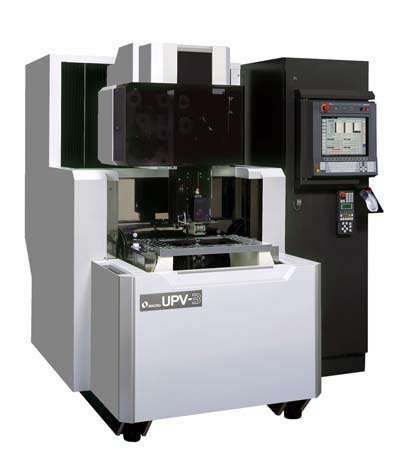
Makino announces the release of the UPV-3 and UPV-5 wire EDM with an oil-based dielectric fluid system for high-accuracy machining of hardened materials and mirror-like surface finishing capabilities. "The oil-based dielectric fluid system design of the UPV series is completely different from our other EDM machinery, offering multiple unique benefits," said Jeff Kiszonas, Makino's EDM product manager. "We've integrated a thermal control system that maintains constant dielectric and casting temperatures, Makino's latest SPG II circuit for improved finishing operations, and our proven high-performance PICO guide system. Together these features create a rigid, reliable, high-accuracy machining platform capable of producing surface finishes to 0.08µm Rz." Makino's UPV machines feature a fixed table design in which axis movements are controlled by machining heads. Sizes of the UPV-3 and UPV-5 are 101.57"x126.97" (2,580mm x 3,225mm) and 113.58"x131.30" (2,885mm x 3,335mm) with X-, Y- and Z-axis travels of 14.57", 10.63", 8.66" (370mm, 270mm, 220mm) and 21.65", 14.57", 8.66" (550mm, 370mm, 220mm), respectively. The UPV-3 will accommodate a maximum workpiece size of 30.71"x23.23"x3.94" (780mm x 590mm x 100mm) with a payload of 771.62 lbs. (350kg), while the UPV-5 holds sizes up to 37.80"x27.17"x 3.94" (960mm x 690mm x 100mm) with a maximum payload of 1,212.54 lbs (550kg). Included in the UPV design are ceramic insulators placed between the worktable and machine casting to reduce stray electric capacitance and enable the SPG II machining circuit to stabilize micro electrical discharges. Utilizing these capabilities under standard machining conditions for a 20mm (0.79") thick work piece measuring up to 100mm x 100mm (3.93"x3.93") users can achieve 0.2µm Rz surface finishes. The table's electrically conductive machining area can also be limited for jobs requiring a surface finish better than 0.2µm Rz. This further reduces stray electric capacitance for surface finishes down to 0.08µm Rz (actual measured value). In similar performance tests using carbide, the UPV machines performed up to 22 percent faster than water-based machines, and up to 78 percent faster than prior oil-based technology with good sealed flushing. The machines' oil-based dielectric fluid systems create a smaller spark gap between the electrode and work piece than standard water-based fluid systems. This facilitates precision machining of narrower slot widths and smaller corner radii in a variety of materials, including hardened metals and polycrystalline diamond (PCD). Using oil-based dielectric fluid also eliminates the soft layer that can result from the EDM process and surface corrosion caused by electrolytic action. In long-run applications where machined parts remain submerged for extended periods, this can be critical in controlling corrosion or oxidation layers susceptible to these effects. The UPV's bed tank system provides enhanced thermal control by circulating temperature controlled dielectric fluid through the machine's lower castings. Simultaneously, Makino's machine temperature control functions adjust air temperatures to that of the dielectric fluid and direct airflow through the machines' upper castings. Controlling the machines' cast-iron parts to the same temperature in this way minimizes changes in machine attitude.
Contact Details
Related Glossary Terms
- electrical-discharge machining ( EDM)
electrical-discharge machining ( EDM)
Process that vaporizes conductive materials by controlled application of pulsed electrical current that flows between a workpiece and electrode (tool) in a dielectric fluid. Permits machining shapes to tight accuracies without the internal stresses conventional machining often generates. Useful in diemaking.
- payload ( workload)
payload ( workload)
Maximum load that the robot can handle safely.
- polycrystalline diamond ( PCD)
polycrystalline diamond ( PCD)
Cutting tool material consisting of natural or synthetic diamond crystals bonded together under high pressure at elevated temperatures. PCD is available as a tip brazed to a carbide insert carrier. Used for machining nonferrous alloys and nonmetallic materials at high cutting speeds.
- precision machining ( precision measurement)
precision machining ( precision measurement)
Machining and measuring to exacting standards. Four basic considerations are: dimensions, or geometrical characteristics such as lengths, angles and diameters of which the sizes are numerically specified; limits, or the maximum and minimum sizes permissible for a specified dimension; tolerances, or the total permissible variations in size; and allowances, or the prescribed differences in dimensions between mating parts.
- wire EDM
wire EDM
Process similar to ram electrical-discharge machining except a small-diameter copper or brass wire is used as a traveling electrode. Usually used in conjunction with a CNC and only works when a part is to be cut completely through. A common analogy is wire electrical-discharge machining is like an ultraprecise, electrical, contour-sawing operation.







